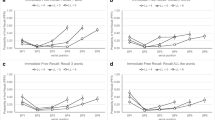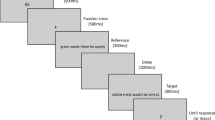Abstract
This report summarizes an experiment designed to study the disruptive effects on immediate recall of interfering with the ability to scan ahead. Sentences were printed on paper tape which was pulled through a window, the size of which could be controlled. There were two exposure widths, three rates of tape movement, and three types of material which varied in length: equational and transitive sentences as well as random strings of words. Errors increase as the exposure width is decreased, and the magnitude of the disruptive effect is most marked for the longer sentences and the faster rate of presentation. A possible explanation is advanced emphasizing the likelihood that Ss store information in a sensory register and scan that register in order to segment sentences into phrases, phrases into words, and words into smaller functional units. As one limits exposure width, one interferes with the transfer of information into the sensory register and with the processing of information after it is stored in the register.
Similar content being viewed by others
References
Aderman, O., and Smith, E. E. (1971). Expectancy as a determinant of functional units in perceptual recognition.Cog. Psychol. 2: 117–129.
Anderson, I. H. (1937). Eye movements of good and poor readers.Psychol. Monogr. 48(3): 1–35.
Atkinson, R. C., and Schiffrin, R. M. (1968). Human memory: A proposed system and its control processes. In Spence, K. W., and Spence, J. T. (eds.),Advances in the Psychology of Learning and Motivation Research and Theory, Vol. II. Academic Press, New York, pp. 89–195.
Averbach, E., and Coreill, A. S. (1961). Short-term memory in vision.Bell Systems Technol. J. 40: 309–328.
Fodor, J. A., and Garrett, M. (1967). Some syntactic determinants of sentential complexity.Percept. Psychophys. 2: 289–296.
Gibson, E. J., Pick, A., Osser, H., and Hammond, M. (1962). The role of graphemephoneme correspondence in the perception of words.Am. J. Psychol. 75:554–570.
Gibson, E. J., Bishop, C. H., Schiff, W., and Smith, J. (1964). Comparison of meaningfulness and pronounceability as grouping principles in the perception and retention of verbal materials.J. Exp. Psychol. 67: 173–182.
Gladney, T. A., and Krulee, G. K. (1967). The influence of syntactic errors on sentence recognition.J. Verbal Learn. Verbal Behav. 6: 292–298.
Krulee, G. K., and Ramsburg, R. E. (1974). Semantic anomalies and sentence recognition.Percept. Mot. Skills 38:1275–1286.
Krulee, G. K., Gapp, A., Landi, D. M., and Manelski, D. M. (1964). Organizing factors and immediate memory span.Percept. Mot. Skills 18: 533–548.
Lappin, J. S., and Lowe, C. A. (1969). Meaningfulness and pronounceability in the coding of visually presented verbal materials.J. Exp. Psychol. 81: 22–28.
Marks, L. E., and Miller, G. A. (1964). The role of semantic and syntactic constraints in the memorization of English sentences.J. Verbal Learn. Verbal Behav. 3: 1–5.
Marks, M. R., and Jack, O. (1952). Verbal context and memory span for meaningful material.Am. J. Psychol. 65: 298–300.
Miller, G. A. (1956). The magical number seven, plus or minus two.Psychol. Rev. 63: 81–97.
Miller, G. A. and Selfridge, J. A. (1950). Verbal context and the recall of meaningful material.Am. J. Psychol. 63: 176–185.
Miller, G. A., Bruner, J. S., and Postman, L. (1954). Familiarity of letter sequences and tachistoscopic identification.J. Gen. Psychol. 50: 129–139.
Neisser, N. (1967).Cognitive Psychology, Appleton-Century-Crofts, New York.
Newman, E. B. (1966). Speed of reading when the span of letters is restricted.Am. J. Psychol. 79: 272–278.
Reicher, G. M. (1969). Perceptual recognition as a function of meaningfulness of stimulus material.J. Exp. Psychol. 81: 275–280.
Simon, H. A., and Chase, W. G. (1973). Skill in chess.Am. Scientist 61: 394–402.
Sperling, G. (1967). Successive approximations to a model for short-term memory.Acta Psychol. 27: 285–292.
Thorndike, E. L. (1921).The Teacher's Word Book, Teacher's College, Columbia University, New York.
Wheeler, D. D. (1970). Processes in word recognition.Cog. Psychol. 1: 59–85.
Author information
Authors and Affiliations
Rights and permissions
About this article
Cite this article
Krulee, G.K., Schwartz, H.R. Scanning processes and sentence recognition. J Psycholinguist Res 4, 141–158 (1975). https://doi.org/10.1007/BF01077034
Received:
Issue Date:
DOI: https://doi.org/10.1007/BF01077034




